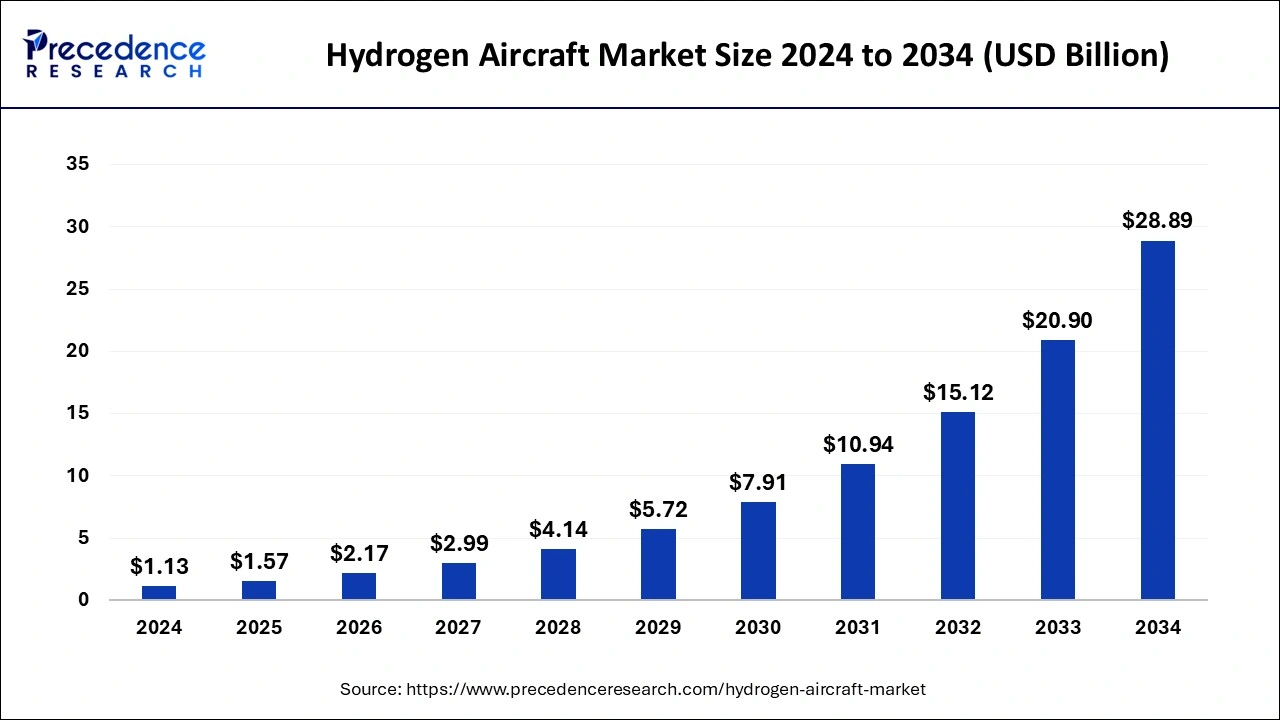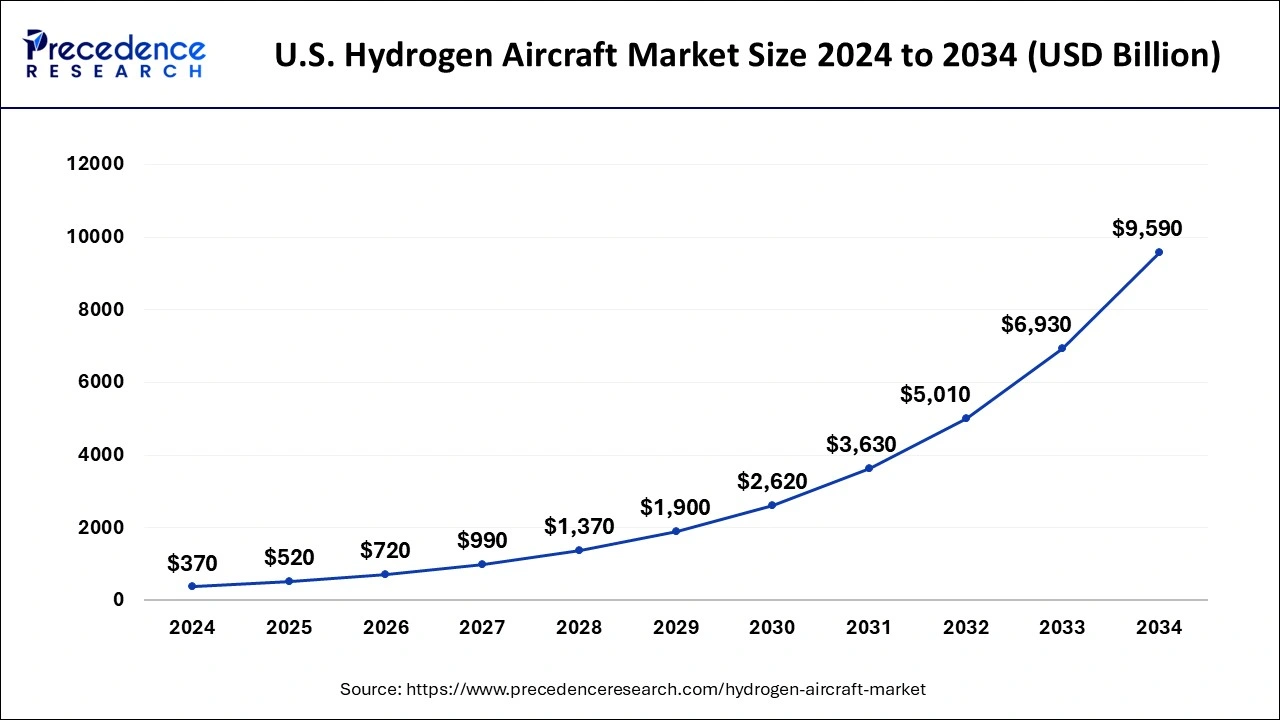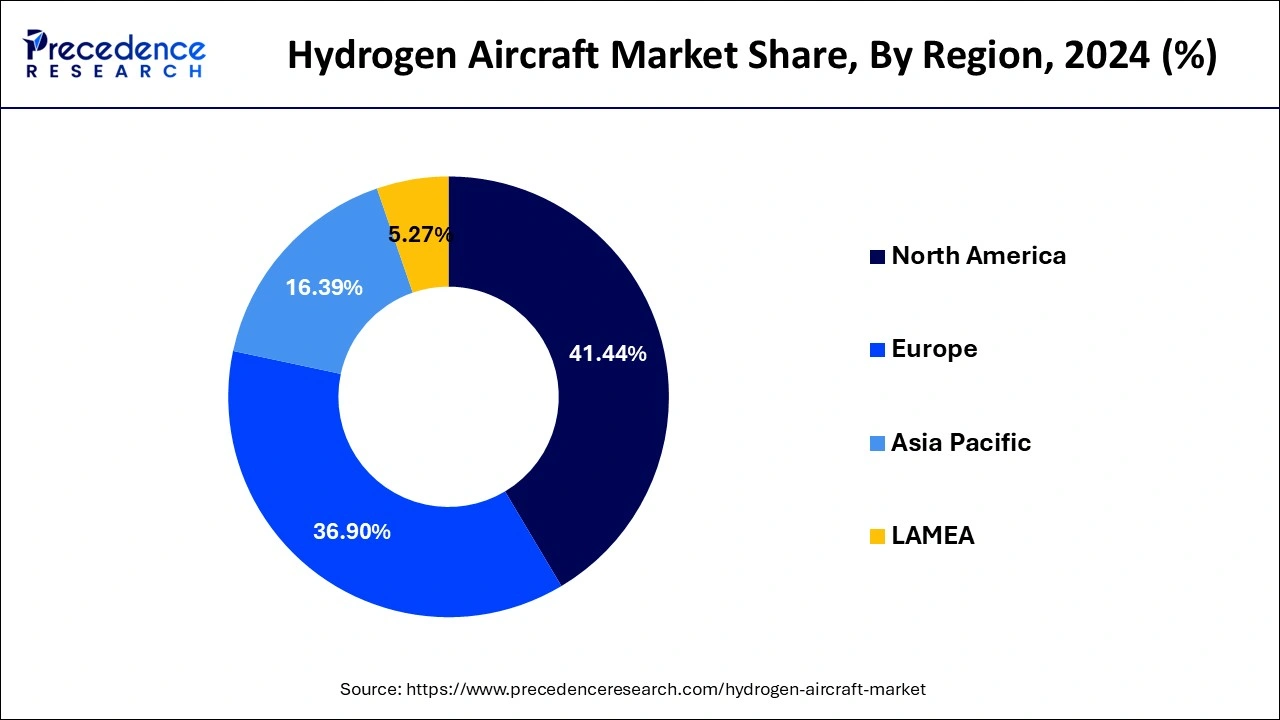List of Contents
Hydrogen Aircraft Market Size and Growth 2025 to 2034
The global hydrogen aircraft market size was valued at USD 1.13 billion in 2024 and is anticipated to reach around USD 28.89 billion by 2034, expanding at a CAGR of 38.24% from 2025 to 2034. The key players operating in the market are focused on adopting inorganic growth strategies like acquisition and merger to develop hydrogen aircraft which is estimated to drive the global hydrogen aircraft market over the forecast period.

Hydrogen Aircraft Market Key Takeaways
- North America dominated the global market with the largest market share of 41.44% in 2024.
- Asia Pacific is projected to expand at the notable CAGR during the forecast period.
- By passenger capacity, the less than 100 segment contributed the highest market share in 2024.
- By range, the short haul segment captured the biggest market share in 2024.
- By range, the medium haul segment is expected to grow at a significant CAGR from 2025 to 2034.
- By technology, the 30–100 liter segment has held the largest market share in 2024.
- By technology, the hybrid electric segments is estimated to be the fastest-growing segment during the forecast period.
How Can AI Improve the Hydrogen Aircraft Industry?
The artificial intelligence integration significantly enhances various aspects of the hydrogen aircraft industry by improving efficiency, safety, and innovation. The AI integration optimizes design and analyze vast amounts of data to optimize the design of hydrogen aircraft, improving aerodynamics, weight distribution, and fuel efficiency.
The artificial intelligence integration assists in predictive analytics can identify potential issues in manufacturing processes, reducing defects and improving the quality of components. The artificial intelligence integration optimizes flight routes, speeds, and altitudes to maximize fuel efficiency and minimize hydrogen consumption. AI-powered autonomous systems can assist pilots in making real-time decisions, enhancing safety and reducing pilot workload. AI algorithms assists in predicting when parts are likely to fail, allowing for timely maintenance and reducing downtime.
AI helps in analyzing market trends, customer preferences, and competitive landscapes to inform business strategies and product development. AI algorithms assists in optimization of pricing strategies based on demand forecasts and market conditions, maximizing revenue.
U.S. Hydrogen Aircraft Market Size and Growth 2025 to 2034
The U.S. hydrogen aircraft market size was evaluated at USD 370 million in 2024 and is predicted to be worth around USD 9,590 million by 2034, rising at a CAGR of 38.47% from 2025 to 2034.

North America was the leading hydrogen air craft market in 2022. The increased demand for the technologically advanced and pure sustainable and eco-friendly transport solutions has propelled the growth of the hydrogen air craft market. Furthermore, the increasing government initiatives to reduce carbon footprint and promote the sustainable transportation across the region is expected to further boost the growth of the market. The growing corporate and government investments towards building electric and hydrogen powered infrastructure to control the carbon emissions to protect environment is fueling the demand for hydrogen aircraft. The strict government regulations pertaining to environment protection is another major factor which is expected to fuel the demand for hydrogen aircraft across the North America. The presence of top multinational companies and the increase in globalization of businesses is boosting the number of domestic and international travels in North American market. The growing need for sustainable and cost effective commute solutions has significantly boosted the growth of the hydrogen aircraft market in North America.

Asia Pacific is anticipated to be the fastest growing market during the forecast period. The rising disposable income, growing demand for fast travelling solutions, rising number of passengers, and presence of huge multinational companies in the region are supporting the growth of the hydrogen aircraft market. The travelling frequency is high among the travelers due to the presence of multinational companies in Asia Pacific region. The government policies have attracted huge investments in the form of FDIs which resulted in the increased number of international travels. Furthermore, the rising government initiatives especially in countries like India and China which are the major attraction for investments for the western countries is favoring the growth of the hydrogen aircraft market. The availability of factors of production at low costs and growing investments in the development of hydrogen powered infrastructure is expected to provide various opportunities due to the manufacturers in the production of hydrogen aircrafts at low costs. Moreover, the huge demand for domestic travels in the Asia Pacific region is further boosting the growth of the market.
Hydrogen Aircraft Market Growth Factors
- The shifting focus of the aviation industry towards de-carbonization, the benefits of hydrogen aircraft over traditional one and growing number of air passengers are the most prominent factors that are expected to augment the growth of the global hydrogen aircraft market.
- The global aviation industry contributes around 2.5% of the total carbon emission across the globe.
- The rising government initiative to reduce carbon footprint and promote the adoption of sustainable and eco-friendly commute solutions is significantly fostering the growth of the hydrogen aircraft market. Various country members of the European Union such as France, UK, and Germany are formulating their own National Hydrogen Strategy to reduce the carbon footprint from the aviation industry.
- The rising concerns over climate change and global warming has forced the governments across the globe to opt for strategies that promotes de-carbonization.
- The governments of various countries who are a part of the Paris agreement are under huge pressure to achieve their climate change targets set up the United Nations to fight the climate change concerns. Therefore, the collective efforts of the different countries to promote the adoption of the sustainable aviation solutions are projected to drive the growth of the global hydrogen aircraft market.
- Increasing awareness of climate change and the need to reduce carbon emissions are driving the aviation industry to seek sustainable alternatives. Hydrogen-powered aircraft offer zero carbon emissions, making them an attractive option for reducing the environmental impact of aviation.
- Governments worldwide are implementing stricter emissions regulations and providing incentives for the development of green technologies. Supportive policies and funding for hydrogen technology development encourage investment in hydrogen aircraft.
- Advances in hydrogen storage, fuel cell technology, and lightweight materials are making hydrogen aircraft more feasible. Innovations in these areas help improve the efficiency and safety of hydrogen-powered aircraft.
- Significant investments from governments, private companies, and research institutions are driving the development of hydrogen aviation. Collaborations between aerospace manufacturers, energy companies, and research institutions are accelerating the progress of hydrogen aircraft technology.
- Growing public awareness and demand for environmentally friendly travel options are pushing the aviation industry to adopt greener technologies, including hydrogen propulsion.
- The potential for job creation and economic growth in the hydrogen sector is another factor driving investment. Developing a hydrogen economy can stimulate innovation and create new market opportunities.
Market Scope
| Report Coverage | Details |
| Market Size in 2025 | USD 1.57 Billion |
| Market Size by 2034 | USD 28.89 Billion |
| Growth Rate from 2025 to 2034 | CAGR of 38.24% |
| Largest Market | North America |
| Base Year | 2024 |
| Forecast Period | 2025 to 2034 |
| Segments Covered | Passenger Capacity, Range, Technology, Application, Distance Range, Platform, and Region |
| Regions Covered | North America, Europe, Asia-Pacific, Latin America and Middle East & Africa |
Hydrogen Aircraft Market Dynamics
Driver
Government initiatives for hydrogen production
The government of United Kingdom launched a second phase of hydrogen production program in December 2022 along with a support for research and development activities. Moreover, the United States Department of Energy in March 2023, announced $750 million research and development program for advanced hydrogen technologies while supporting the clean energy initiative.
Government initiatives aimed at promoting hydrogen production have a significant impact on driving the growth of hydrogen aircraft market. These initiatives create a conducive environment for the research and development of hydrogen aircraft. Financial incentives, grants or subsidies by the government also encourage the development of aircraft. Additionally, the establishment of hydrogen fueling infrastructure incentivizes airlines to consider transitioning to hydrogen powered aircraft. Furthermore, government-led regulations and targets aimed at reducing greenhouse gas emissions from aviation provide a strong impetus for the adoption of hydrogen technology. Government initiatives have potential to accelerate the advancements in this sustainable transportation solution and thus, such initiatives are observed to act as a driver for the market's growth.
Restraint
Technical challenges
Technical challenges are considered to hinder the overall growth of hydrogen aircraft market. Transitioning from the traditional aviation fuels to hydrogen-powered aviation mode involves intricate complexities. Firstly, designing efficient hydrogen fuel cells and propulsion systems demands skilled engineering to achieve comparable performance to conventional aircraft engines. Moreover, lack of established infrastructure for producing, transporting and refueling hydrogen at airports, which needs substantial investments. All these challenges create a major restraint for the market.
Opportunity
Major airlines transforming into hydrogen-powered solutions
In the fourth quarter of 2022, United Airlines and British Airways stated that they are aiming to use hydrogen powered planes by 2030, especially for short haul flights. Moreover, Delta Airlines has also partnered with Airbus to develop a hydrogen-powered passenger plane. Such transformation of major airlines into hydrogen-powered entities serves as a potent opportunity for the hydrogen aircraft market. This trend fosters a positive feedback loop within the market. Increasing demand for hydrogen-powered aircraft encourages manufacturers to invest in research and development, resulting in improved aircraft efficiency, longer flight ranges and enhanced safety features. These advancements, in turn, attract more airlines to adopt hydrogen-powered aircraft accelerating the overall market's expansion.
Challenge
High cost of production
The high cost of production required for hydrogen aircraft presents a significant challenge for the market. Hydrogen technology, while a promising potential to reduce carbon emissions in aviation, currently faces obstacles that hinder widespread adoption. The production of hydrogen is energy-intensive, requiring methods that involve substantial investment as well as energy consumption. This results in elevated production costs compared to conventional fossil fuels. Moreover, the development and establishment of a hydrogen infrastructure, including production, storage and distribution facilities demands substantial investment.
Passenger Capacity Insights
Based on the passenger capacity, the hydrogen aircraft market is segregated into less than 100, 101 to 200, and Above 200. In 2022, less than 100 segment dominated the global hydrogen aircraft market. This growth is primarily due to the growing investments and ongoing development works on the development of safer, efficient, and sustainable hydrogen aircrafts that can carry less number of passengers for the time being. The rising investments on the technological advancements of this less capacity aircraft makes this segment the fastest-growing segment.
Range Insights
Based on the range, the short haul segment was the leading segment in 2022 followed by the medium haul segment. This is owing to the rising demand for the drones across the globe. Moreover, the ongoing technological advancements regarding the development of short range aircrafts has resulted in the dominance of this segment across the globe. The increasing demand for the domestic travel across the globe and rising number of air passengers is significantly boosting the growth of the short haul hydrogen aircraft market.
Medium haul segment is expected to exhibit the highest CAGR during the forecast period. The rising investments in the research and development of extending the distance range of the hydrogen aircrafts is expected to fuel the growth of this segment. Furthermore, the rising number of international and domestic travels across the globe, owing to the globalization of business and rapidly growing tourism industry is expected to foster the growth of this segment during the forecast period. Medium haul will enable the aircraft operators to earn extra profits.
Technology Insights
Based on the technology, the hybrid electric aircraft was the dominant segment in 2022. This dominance is attributed to ability of the hybrid aircraft to run using both the hydrogen and electric power. The shortage of one fuel may be fulfilled by using the alternative fuel. The electric power infrastructure is developed as compared to the hydrogen power infrastructure. Moreover, the increasing adoption of the hybrid electric aircraft owing to the rising concerns over the carbon emissions is expected to fuel its demand during the forecast period.
The fully hydrogen aircraft is anticipated to be the fastest-growing segment during the forecast period. The rising investments in the development of strong hydrogen power infrastructure across the developed and developing countries is expected to fuel the demand for the fully hydrogen powered aircrafts. The hydrogen power is more eco-friendlier than the electric power and the rising focus towards achieving 100% sustainable transport solutions is attracting more investments towards the development of the hydrogen infrastructure across the globe. Thus the demand for the fully hydrogen-powered aircraft segment is expected to grow at the highest CAGR during the forecast period.
Hydrogen Aircraft Market Companies
- Aerodelft
- Aerovironment Inc.
- Airbus Se
- Apus Group
- Doosan Mobility Innovation
- Flyka
- Gkn Aerospace
- Hes Energy Systems
- Honeywell International Inc.
- Hypoint Inc.
- Intelligent Energy Holdings
- Pipistrel D.O.O
- Plug Power Inc.
- Shanghai Pearl Hydrogen Energy Technology Co. Ltd.
- Urban Aeronautics Ltd.
- Zeroavia Inc.
Latest Announcements by Hydrogen Aircraft Industry Leaders:
- In July 2024, Rolls-Royce's Director of Research and Technology, Alan Newby, stated that the business is pleased to have TCS join its hydrogen research program and that their engineering expertise would be helpful in achieving our technological objectives. The Rolls-Royce company already come a long way, and having TCS on board gives the business more capabilities as Rolls-Royce continues its journey to facilitate the aviation industry's energy transition. TCS also demonstrated its technology capabilities in the aviation sector at the Farnborough International Airshow, when this expanded relationship was announced.
New Advancements in Hydrogen Aircraft Industry
- In July 2024, GKN Aerospace, aerospace company, revealed the introduction of the H2FlyGHT, 45,74,240 US$ project to innovate a 2-megawatt (MW) cryogenic hydrogen-electric propulsion system, setting standards for the next generation of larger sustainable aircraft. H2FlyGHT offers cutting-edge thermal management technologies to improve performance and efficiency, building on the achievements of the H2GEAR project.
- In May 2024, In order to showcase small-scale liquid hydrogen aircraft ground operations at three European airports, Airbus has initiated an innovative aviation hydrogen handling and refueling initiative with assistance from academic partners, airport operators, and top hydrogen-industry businesses. Hydrogen is becoming increasingly popular for both stationary and mobile applications as a result of the push to decarbonize our economy and advance Europe's energy independence.
Segments Covered in the Report
By Passenger Capacity
- Less than 100
- 101 to 200
- Above 200
By Range
- Short Haul
- Medium Haul
- Long Haul
By Technology
- Fully Hydrogen-Powered
- Hybrid Electric Powered
- Hydrogen Fuel Cell Aircraft
- Liquid Hydrogen Aircraft
By Application
- Passenger Aircraft
- Cargo Aircraft
By Distance Range
- Up to 20 km
- 20 km to 100 km
- More than 100 km
By Platform
- Unmanned Aerial Vehicles
- Air Taxis
- Business Jets
By Geography
- North America
- Europe
- Asia-Pacific
- Latin America
- Middle East & Africa (MEA)
For inquiries regarding discounts, bulk purchases, or customization requests, please contact us at sales@precedenceresearch.com
Frequently Asked Questions
Ask For Sample
No cookie-cutter, only authentic analysis – take the 1st step to become a Precedence Research client